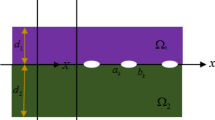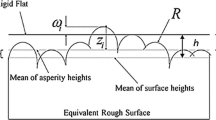Abstract
The shapes of the interfacial delamination crack and stress states during wedge indentation in a soft-film-on-hard-substrate system were investigated systematically using the three-dimensional (3D) finite element simulation and wedge indentation experiment. In the simulation, a traction–separation law was used to characterize the failure behaviors of the interface. The effects of the wedge indenter tip length and the film thickness on the onset and growth of interfacial delamination were analyzed. It was shown that a two-dimensional (2D) to 3D transition of stress states occurred depending on the ratio of indenter length to film thickness. Furthermore, the interfacial delamination process by wedge indentation was conducted experimentally, and comparisons between the computational and experimental results yielded quantitative good agreement. Finally, a straightforward criterion based on the curvature of the delamination crack front was proposed to indicate the transition of stress states during the interfacial delamination. A guideline was therefore proposed to classify the 2D and 3D stress states for extracting the interface adhesion properties.
















Similar content being viewed by others
References
J. Malzbender, J.M.J. den Toonder, A.R. Balkenende, and G. de With: Measuring mechanical properties of coatings: A methodology applied to nano-particle-filled sol-gel coatings on glass. Mater. Sci. Eng., R 36, 47 (2002).
M.D. Kriese, D.A. Boismier, N.R. Moody, and W.W. Gerberich: Nanomechanical fracture-testing of thin films. Eng. Fract. Mech. 61, 1 (1998).
Y.G. Wei and J.W. Hutchinson: Mixed-mode fracture analyses of plastically-deforming adhesive joints. Int. J. Fract. 93, 315 (1998).
M. Lane: Interface fracture. Annu. Rev. Mater. Res. 33, 29 (2003).
A.A. Volinsky and W.W. Gerberich: Nanoindentaion techniques for assessing mechanical reliability at the nano-scale. Microelectron. Eng. 69, 519 (2003).
M.D. Kriese, W.W. Gerberich, and N.R. Moody: Quantitative adhesion measures of multilayer films: Part I. Indentation mechanics. J. Mater. Res. 14, 3007 (1999).
M.D. Kriese, W.W. Gerberich, and N.R. Moody: Quantitative adhesion measures of multilayer films: Part II. Indentation of W/Cu, W/W, Cr/W. J. Mater. Res. 14, 3019 (1999).
X. Li and B. Bhushan: A review of nanoindentation continuous stiffness measurement technique and its applications. Mater. Charact. 48, 11 (2002).
D.B. Marshall and A.G. Evans: Measurement of adherence of residually stressed thin films by indentation. I. Mechanics of interface delamination. J. Appl. Phys. 56, 2632 (1984).
M.V. Swain and J. Menčik: Mechanical property characterization of thin films using spherical tipped indenters. Thin Solid Films 253, 204 (1994).
A.A. Volinsky, N.R. Moody, and W.W. Gerberich: Interfacial toughness measurements for thin films on substrates. Acta Mater. 50, 441 (2002).
A.A. Volinsky, J.B. Vella, and W.W. Gerberich: Fracture toughness, adhesion and mechanical properties of low-k dielectric thin films measured by nanoindentation. Thin Solid Films 429, 201 (2003).
M.R. Begley, D.R. Mumm, A.G. Evans, and J.W. Hutchinson: Analysis of a wedge impression test for measuring the interface toughness between films/coatings and ductile substrates. Acta Mater. 48, 3211 (2000).
M.P. De Boer and W.W. Gerberich: Microwedge indentation of the thin film fine line-I. Mechanics. Acta Mater. 44, 3169 (1996).
M.P. De Boer and W.W. Gerberich: Microwedge indentation of the thin film fine line-II. Experiment. Acta Mater. 44, 3177 (1996).
M.D. Drory and J.W. Hutchinson: Measurement of the adhesion of a brittle film on a ductile substrate by indentation. Proc. R. Soc. Lond., Ser. A 452, 2319 (1996).
J.J. Vlassak, M.D. Drory, and W.D. Nix: A simple technique for measuring the adhesion of brittle films to ductile substrates with application to diamond-coated titanium. J. Mater. Res. 12, 1900 (1997).
K.B. Yeap, K.Y. Zeng, H.Y. Jiang, L. Shen, and D.Z. Chi: Determining interfacial properties of submicron low-k films on Si substrate by using wedge indentation technique. J. Appl. Phys. 101, 123531 (2007).
K.B. Yeap, K.Y. Zeng, and D.Z. Chi: Determining the interfacial toughness of low-k films on Si substrate by wedge indentation: Further studies. Acta Mater. 56, 977 (2008).
L. Chen, K.B. Yeap, K.Y. Zeng, and G.R. Liu: Finite element simulation and experimental determination of interfacial adhesion properties by wedge indentation. Philos. Mag. 89, 1395 (2009).
W.Z. Li and T. Siegmund: An analysis of the indentation test to determine the interface toughness in a weakly bonded thin film coating substrate system. Acta Mater. 52, 2989 (2004).
Y.W. Zhang, K.Y. Zeng, and R. Thampurun: Interfacial delamination generated by indentation in thin film systems—a computational mechanics study. Mater. Sci. Eng., A 319, 893 (2001).
M. Schulze and W.D. Nix: Finite element analysis of the wedge delamination test. Int. J. Solids Struct. 37, 1045 (2000).
V. Tvergaard and J.W. Hutchinson: Toughness of an interface along a thin ductile layer joining elastic solids. Philos. Mag. 89, 641 (1994).
V. Tvergaard and J.W. Hutchinson: Effect of strain-dependent cohesive zone model on predictions of crack growth resistance. Int. J. Solids Struct. 33, 3297 (1996).
C.M. She, Y.W. Zhang, and K.Y. Zeng: A three-dimensional finite element analysis of interface delamination in a ductile film/hard substrate system induced by wedge indentation. Eng. Fract. Mech. 76, 2272 (2009).
W.C. Oliver and G.M. Pharr: An improved technique for determining hardness and elastic modulus using load and displacement sensing indentation experiments. J. Mater. Res. 7, 1564 (1992).
X.P. Xu and A. Needleman: Numerical simulations of fast crack growth in brittle solids. J. Mech. Phys. Solids 42, 1397 (1994).
ABAQUS: User Manual, Version 6.9 (SIMULIA, Providence, RI, 2009).
K.L. Johnson: The correlation of indentation experiments. J. Mech. Phys. Solids 18, 115 (1970).
J.W. Hutchinson and Z. Suo: Mixed mode cracking in layered materials, in Advances in Applied Mechanics, Vol. 29, edited by J.W. Hutchinson and T.Y. Wu (Academic Press, Burlington, 1992), pp. 63–191.
S. Kobayashi: Differential Geometry of Complex VectorBundles (Princeton University Press, Princeton, NJ, 1987), p. 192.
J. Zhu, K.B. Yeap, K.Y. Zeng, and L. Lu: Nanomechanical characterization of sputtered RuO2 thin film on silicon substrate for solid state electronic devices. Thin Solid Films 519, 1914 (2011).
Acknowledgments
This work is supported by National University of Singapore under Academic Research Funds (R265-000-190-112 and R265-000-190-133) and National Natural Science Foundation of China (No. 50805079).
Author information
Authors and Affiliations
Corresponding author
Rights and permissions
About this article
Cite this article
Chen, L., Yeap, K.B., Zeng, K.Y. et al. Interfacial delamination cracking shapes and stress states during wedge indentation in a soft-film-on-hard-substrate system—Computational simulation and experimental studies. Journal of Materials Research 26, 2511–2523 (2011). https://doi.org/10.1557/jmr.2011.175
Received:
Accepted:
Published:
Issue Date:
DOI: https://doi.org/10.1557/jmr.2011.175




